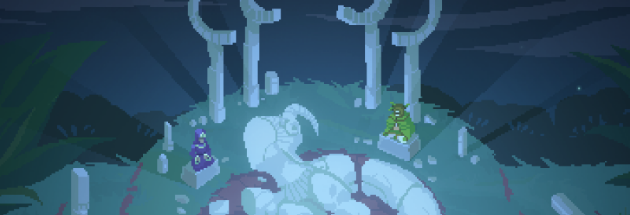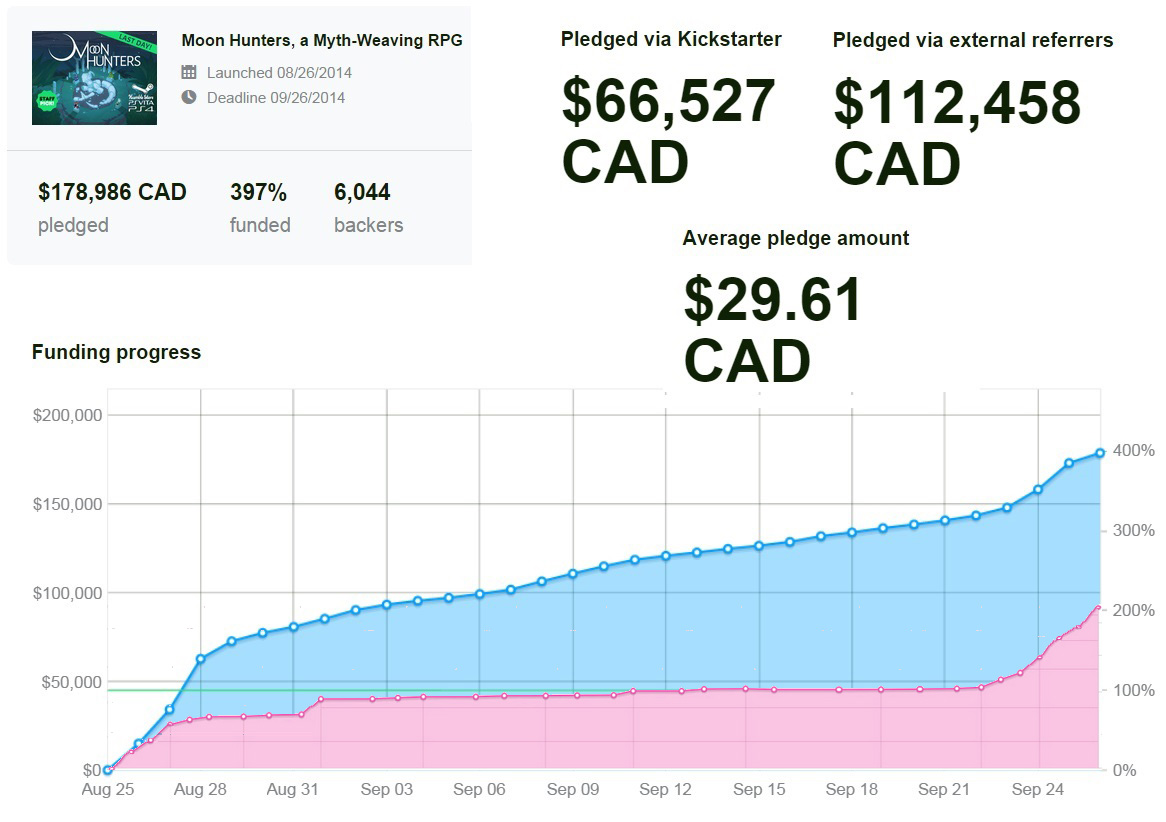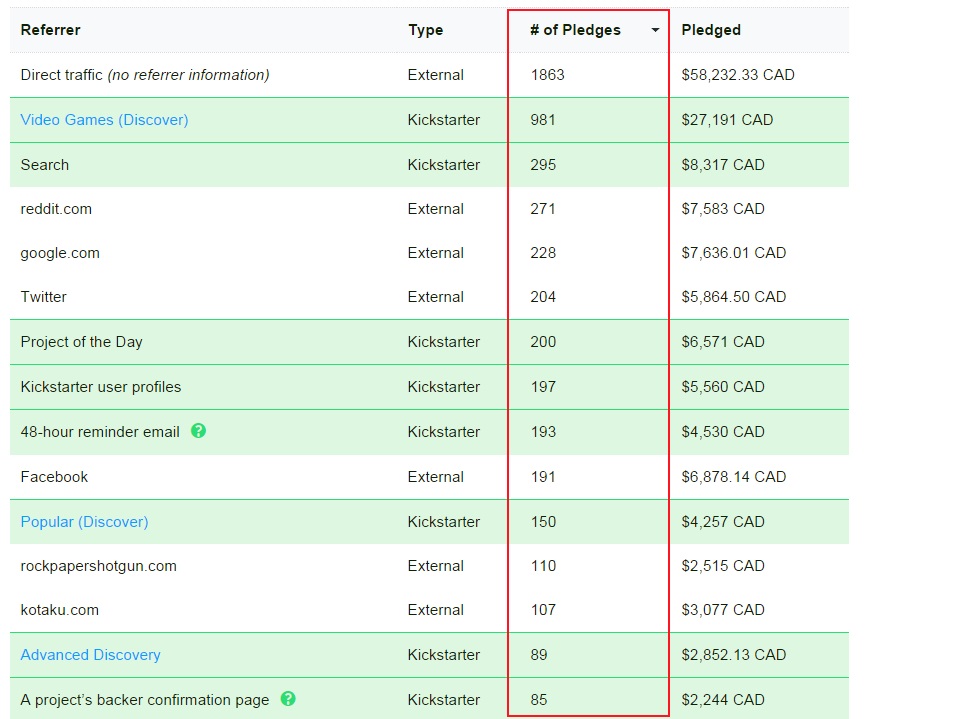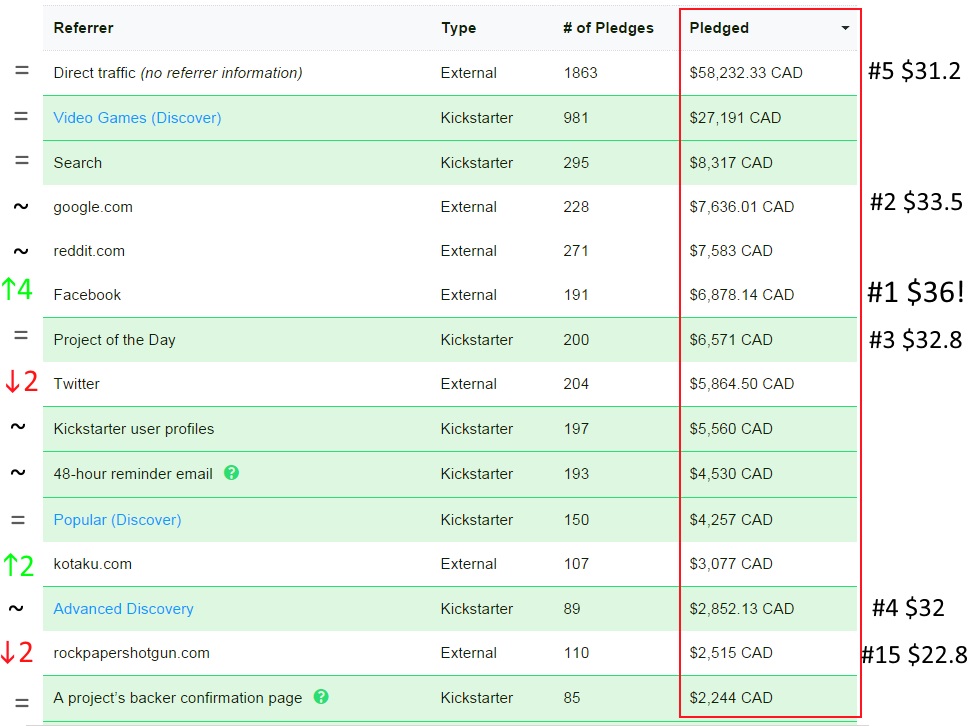
Featured Blog | This community-written post highlights the best of what the game industry has to offer. Read more like it on the Game Developer Blogs or learn how to Submit Your Own Blog Post
Moon Hunters Kickstarter Post-Mortem: Stats, Anxieties, and Success
One indie studio shares their strategies and findings from their first Kickstarter, which earned $179,000, nearly 400% of their goal.


Tanya X. Short is the Creative Director of Kitfox Games,whose Kickstarter for Moon Hunters recently ended. Their first game, Shattered Planet, released to Steam in July 2014. Update: Ian Kragh pulled official stats on the campaign, available for you to view here!
Overview
Kitfox Games is a 4-person studio in Montreal, Canada.
Our Moon Hunters Kickstarter was our first such campaign, and we asked for $45,000 CAD as a base funding goal. When it closed, we had earned $178,986, which was nearly 400%, from 6,000+ fans. By all measures, it was a great success.
If you’re reading this hoping to understand our strategy, here it is: we tried to convince our fans it was worth their time and energy to tell their friends, family, and the world. Facebook, Twitter, and Reddit were our top sources of backers, much higher than any press coverage.

However, please understand that there are many avenues to success. I have spoken with other Kickstarter managers and their strategies are sometimes completely different. One individual who had helped with a series of high-profile indie campaigns advised that he always chases press first, and that tends to be his highest source of income. I’m glad it works for him, but ours was the reverse.
Furthermore, due to Survivorship Bias, it is generally more useful to learn from failures than from successes. So I recommend everyone to do some hunting and find those devs brave enough to talk about their unfunded campaigns... and give more weight to their learnings than you do to mine.
I wish the best of luck to all game developers, and simply urge you to assess your game’s appeal honestly, and strategize accordingly.
Note: all dollar amounts cited will be in CAD, as our campaign was hosted by Kickstarter of Canada, despite the fact that most of our backers were Americans.
Preparations
We first put Moon Hunters on the Square Enix Collective site in January 2014. We were one of the projects in its first cohort, proud to be alongside World War Machine and Game of Glens. We managed to scrape 1,000+ newsletter signups our of that initiative, which was covered by all the major press, even if the reporters showed a bit of healthy scepticism.
We built our community via blog and newsletter for eight months before launching the Kickstarter campaign on August 26th. We had almost no press coverage during that time, yet our newsletter subscribers slowly grew. This newsletter was, in my opinion, our #1 advantage.
While the rest of the team finished up Shattered Planet, Xin Ran Liu (our artist) developed the Moon Hunters art style, iterating several times to find his voice in pixel art. Similarly, I used that time to work on the core feature and world design, plus get some practice talking about them to players and journalists. So it was six months before our programmers, Jongwoo Kim and Mike Ditchburn, started full-time on prototyping.
By early August, we had a very simple prototype, with stand-alone scenes of combat, dialogue, and scripted sequences. It wasn’t production-approved code, it wasn’t a “game”, but we knew what we needed from it to make a representative gameplay video. And maybe more importantly, we knew what we thought was cool about the game, as a concept, and had ideas of how to show that to players. So Xin and I took two weeks to make a video and prep our page. By the end of August, we were finally ready.
Expectations
Seeing our funding goal, non-developers usually commented, “Yeah, $45k sounds about right for that kind of game.”
One snide individual even said, "I bet I could make that game in two months."
But developers usually commented, “$45k? What the heck could you afford to do for that? You have four full-time developers! You're making an RPG! That takes YEARS!”
Before the Kickstarter, we had access to enough cash to barely scrape by making the game. However, our existing funds (from Shattered Planet sales, an external investment, and a government fund) allowed us no buffer zone or extra bugfixing time.
We pay ourselves as little as we can, but multiple members have to pay debts in addition to their usual eating, rent, etc. We literally cannot “work for free” (i.e. make the game without paying ourselves), and even minimum wage adds up over time. Those of you who can afford to do “sweat equity” have a great advantage over us. But we knew, looking at the budget, that despite our funding, we would probably have to do Early Access, which isn't ideal for a game like Moon Hunters.
So the Kickstarter served three purposes, in order of priority:
Money: enough to develop the game to a polished, complete state
Community Building: a word-of-mouth & press push worth the time/effort
Risk Management: failing now would indicate the game itself wasn’t good enough
So, at a minimum, we figured $22k profits would cover the Kickstarter labor and also help fund a two extra months of development… which, combined with Quebec taxes, fees, backer reward costs etcetera, meant we needed to ask for $45,000 as a funding goal.

Before we launched the campaign, each team member guessed how much we’d end up with (we do this for all launches, as an experiment in predictive powers). The lowest guess was $48k and the highest was $80k. In short, we expected to reach our goal but not double it. Healthy optimism.
All signs from our research of other Kickstarters pointed to a quick first few days, a flat line, and another peak at the end. This is how most Kickstarters work. Other than a few lucky tweets or press coverage (which is harder and harder to acquire), usually donations flat-line.

We braced ourselves for a long haul. But then...
Results
We were funded on day 3, while Jongwoo Kim (one of our programmers) and I were off managing the Kitfox booth at PAX Prime, honored as part of the Indie MegaBooth.
It was a bit stressful having half the team away while the remainder try to manage an unexpectedly successful campaign, especially since there was no wi-fi at our PAX booth and I hadn’t bought an international data plan. So every few hours, I would run across the convention center to check my email and messages from the team to see if there were any emergencies. Xin responded to questions, we hurriedly solidified our stretch goal plans, strategised how best to proceed, and hoped.
The campaign never quite flat-lined like we expected it to. It did calm down to $1k a day at some points, but… that’s obviously not the same as suffering the (normal) terrors of $0/day.

Other benefits received as part of the Kickstarter:
800 new Twitter followers (from 700 to 1500)
500 new Facebook Likes (from 700 to 1200)
800 new mailing list subscribers (from 1300 to 2100)
a few thousand bonus website visitors
a few dozen extra Shattered Planet sales & coverage requests
new relationships with other indies that Kickstarted around the same time
Of course, our friends and family joke that we're rich now. Hahaha. No. We continue to pay ourselves essentially minimum wage, to reach the point where we can release Moon Hunters at its highest-quality point. In fact, we pay our contractors more than we pay ourselves, in the hopes that the game's sales will let us live more comfortably when it releases.
But all that is in the future. Post-mortems are about the past.
First, the happy part.
What Went Right
There is likely an alternate dimension in which we didn’t reach our initial funding target in the first few days. In that scenario, it is likely that we didn’t reach it until the final week, in which case we would have earned ‘only’ $60k or $70k. That would have satisfied us. So why did things go unexpectedly well?
It’s important to note that we did not follow a formula, and there is no formula to be followed -- no matter how much preparation or planning, no matter how cool a game concept is, there is always always an element of luck in any success. We were lucky, Survivorship Bias, etc.
However, a few things we did seemed to pay off as planned, that we feel proud of:
Groundwork: The six to eight months of promotion (even just once a month) did seem to create the potential for a snowball effect. The video we produced for the campaign, using completely new footage, seemed to resonate with the fans we’d built up, satisfying their expectations.
Square Enix Collective: As a relatively new studio, the added legitimacy of a Square Enix stamp of approval couldn’t have hurt, and their mailing list likely also helped create a chance for the snowball effect. The game concept we put together had a great overlap with their fanbase.

Feedback Incorporation: With our game up and building momentum for eight months, we got a lot of feedback. Some positive, some negative. We focused on what people loved and basically ignored any “haters”. If we got criticism that showed fundamental misunderstanding of the game, or that was “neutral”, we took that more seriously as a marketing/messaging error, but our #1 goal was to identify what people liked about the idea (in our case, “mythology-building”), and bring it to the front while also making those features our top development priority.
Video Structure: 1 minute of minimal-text gameplay, followed by 3 minutes of team interviews. This structure allows viewers to immediately understand the game’s possible appeal, while also giving a chance for viewers on the fence to be persuaded by getting to know the people behind the project. We paid a local (very talented) film-maker (thanks Mattias!) to do the team interviews/filming/editing part, and it was money well spent.
Animated gifs always win: not much to say there. I think we picked a good assortment of quickly-loaded gifs that show different aspects of the game (some familiar, some intriguing), and animation catches the eye.
Lowest possible funding goal: Our goal covered even less than the game we wanted to make -- we literally cut everything possible to cut and turned those into stretch goals, such as a fourth biome/environment and digital art book. It was primarily to not overcommit (a good producer always knows what's cuttable), but had the side-effect of making it possible to reach our funding goal that much more quickly.
Stretch goals revealed when emotionally relevant: By keeping our stretch goals mysterious at the start and revealing as we went, we could A) have something new to post an update about and rally the troops, and also B) take the time to double-check our math in how we arrived at those goals, before announcing them.
No playable demo: I know, I know, demos are ideal. But almost nobody expected one. We were fairly transparent in the fact that we were early in development and so we didn’t have a demo yet, and people seemed content with that. So I’m glad we didn’t spend extra effort hacking something together, and instead used that time to polish our video and page. Note that journalists would probably have been more likely to cover us, if we'd had a demo.
Previous (non-crap) shipped title a definite bonus: Nobody seemed to care that I used to work in MMOs (since Moon Hunters isn't an MMO), but they did care that Kitfox had worked together as a team and released Shattered Planet. Shattered Planet hasn’t won any awards, but it has its own loyal following, which is good enough for someone to think, “Well, these Kitfox people have made a game before.” We got explicit comments from multiple backers that our previous title added confidence, even though they hadn’t played it.
Few physical rewards: Out of 6000+ backers, we only have to sort out 320 or so packages, and 400 or so postcards. It’ll still be a chore, but more manageable than if we had been more loose about giving away extra swag.
Press Approach: Square Enix generously covered a consultation from Agency, which was a great resource for us in getting a completely unbiased opinion from experts on the Kickstarter page. However, the best learning from them their suggestion to not mention the Kickstarter in our emails to press. We invited press to view our new (gameplay-only) trailer, come meet us at PAX, or talk about Collective if they’d covered it before, but not a single word about our campaign. Again, we didn’t have massive press coverage and the coverage we did get didn’t seem essential to our success, but every bit counts, and those bits likely needed a chance to get intrigued by the game itself before being possibly put off by the fact that the game was Kickstarting.
What Went Wrong
Promising PlayStation 3: The biggest, most obvious learning was my own ignorance of console development. Without talking to the programmers (due to sudden funding while I was out of town at PAX), I decided to offer “PlayStation 3 and 4 version” as one of our first stretch goals, at $75k! When we achieved it, we said any tier with keys entitled you to either Steam or PlayStation keys.
But, as it turns out (as the programmers knew and would have told me if I'd asked) the PlayStation 3 is actually much harder to develop for than the PlayStation 4! Although both are technically supported by Unity, it’s nowhere near as simple for 3.
So, two days after we had achieved the “PlayStation 3 and 4 version” stretch goal, we loudly amended it to be only “PlayStation 4 version”, with no PS3 version in the works at all. We only got 1 actual complaint, but a few days later we did get a slew of canceled pledges. Were they related? Probably. Did we look silly? Definitely.
Add-ons are confusing: We didn’t want to give away extra T-shirts and posters and other physical rewards to people who didn’t actually want them -- that would be the height of unnecessary waste, of money and labor both. But many people don’t know what an add-on is, and it’s a weird process to manually adjust your pledge a certain amount to indicate you want an add-on. We anticipate spending a few weeks just sorting through add-ons, and we’ll probably make a few mistakes when we compile all of our mailing lists as a result, but unless Kickstarter implements some kind of ‘shopping cart’ system (which is probably illegal or something), I’m not sure there are any better options.
Undervalued beta access & soundtrack: we’re pretty sure people would have paid more than we asked for beta access and copies of the soundtrack… we erred on the side of having more beta players, but if we had priced them a bit higher, we probably could have achieved a higher average pledge?
Over-eagerness to fulfill rewards: I’m the kind of person that “gets stuff over with” rather than procrastinate… so I decided I would send out our physical rewards ASAP, right now, before diving into deep production on the game. The problem with this approach is that you can only ever send one survey per backer tier through Kickstarter, ever. So I had to ask people ALL of their information, even choosing what kind of key they wanted, even though there is about a 99.999% chance they will want to change their mind between now and when the game ships. I suspect this will cause way more headaches than it was worth.

Not enough stretch goal research: When I left for PAX on the second day of the campaign, I had no idea we’d be funded while I was gone. If I had, we probably would have done more than just make an initial wish-list of stretch goals with strategically chosen values. We would have, for example, had the programmers go through and sanity-check everything we were promising… sorry, Mike and Jongwoo!
Platform choice could have been better-researched: we got a lot of questions about our choice of PlayStation 4 and PlayStation Vita, especially from fans of Xbox One and Wii-U. And when they asked why we had made our choices… well, we didn’t have statistics to back it up. We only had gut feelings that Moon Hunters felt like a game that would perform better on PS4, but no evidence or special deals with Sony, which would have been ways to support our position as developers.
Unsolved Mysteries
These things might have gone right or wrong. Without visiting all alternate dimensions, it’s impossible to know.
Why did we appeal to randos browsing Kickstarter? We’re super-grateful to Kickstarter and all of its channels as a commerce platform, because a full 37%, $66,000, of our money came from their channels. That’s a lot! Probably-maybe more than most! Something we did “clicked” with gamers on Kickstarter specifically -- if I had any idea what it was exactly, I’d tell you.
Did running during PAX help? If so, how much? We launched the day before I left to speak at PAX Dev and manage our booth at PAX Prime, and we were funded while we were there. I definitely met and hugged a few backers, and people who proclaimed proudly to me that they would back when they got home, and also met with a bunch of small press. I have a strong feeling that it’s part of why our funding-slope on the chart does’t flatline in days 4 and 5... but… I have no idea how to quantify how our profile was raised during that time, and how much of it turned into Kickstarter dollars.
Did avoiding a $1/”goodwill” tier help? I think it helped make the $10 (actual lowest) tier seem more reasonable/appealing as a psychological “floor” of spending, but I can’t be sure. It's worthwhile to note that people can always just fund for $1 if they want to, and 101 did.
What was the effect of very few high-end rewards that max out at $1500? Both of our top rewards were taken in the first week. Which was sticky -- we couldn’t introduce new higher rewards for fear of devaluing our two top supporters, and we didn’t have much else to offer anyway. Maybe we would have gotten more if we’d made more room for super-funders?
Should we really have promised 4 platforms, including 2 consoles? As a new studio without console experience, our promises of PlayStation 4 and PlayStation Vita are brave, if not arrogant. It definitely caught the attention of some fans, and allowed us to get featured on the PlayStation blog, but will we end up disappointing some people? I hope not. Only time will tell.

Did giving away copies of the soundtrack add or reduce its value? The trailer's song was one of its distinctive components. We currently have 4000 copies of the soundtrack set to be given away, most of which are going to people who didn’t explicitly ask for it. Will this raise the profile of our talented composers Ryan Roth and Halina Heron, or will it make the $10 soundtrack price tag seem more outlandish when it releases?
Were T-shirts worth it? Comparing resources spent and received, our T-shirt tier is set to be our least profitable, which we anticipated when we created it. But maybe some of those people are more emotionally invested because they backed at a higher tier, and maybe their loyalty will keep growing as they wear the shirt around and it becomes part of their identity when they wear it with their friends.

What’s the right frequency of updates? We updated every 3-5 days, resulting in 11 over the course of the campaign. We took the attitude that we wanted each update to be meaningful and worth the effort of reading, offering new information. But some people think constant engagement with daily updates (or more!) is more effective, and maybe it is.
Did shout-outs to other Kickstarters help? After the first update, each one contained 2-3 links with pictures to other campaigns that we thought had good audience overlap -- games that our backers might be interested in. No idea if it helped us at all, but we're glad we could kick it forward a bit.
Can a campaign page be too long/detailed? When seeking feedback before the campaign’s launch, some other devs commented that we had a LOT of information -- lots of pictures, but also lots of text. But this is the kind of complaint that’s hard to measure during a campaign, since it could just result in fatigue and not funding -- but it’s impossible to know why someone doesn’t fund. I don’t think we had too much, but that’s a personal taste question. I’m not even sure too much is actually possible, but if it is…?
716 people were ‘upsold’ (increased their pledge). Is that a lot? When we reached the Familiars System stretch goal, we devised a new digital-reward goal, to upsell normal backers from $15 (two copies of the game) up to a $20 “Meow Hunter” pledge, in exchange for a limited-edition Black Cat pet and digital art book. It was a very good deal, and most of those 700 people were Meow Hunters. But no idea what the average is.
174 people ($5,600+) canceled their pledge, with a high average pledge. Is that a lot? No idea what the average is. But even if all of those $5,600 were PlayStation 3 die-hard fans, upset when we canceled our PS3 support, it was probably worth it for us. The PS3 version would definitely have cost us more than $6000.
Backer Sources & Statistics
Our top 15 sources of backers were unexpectedly social media driven. We learned that Kitfox, unlike some other successful Kickstarters, has a primary strength via social media. Part of this is probably the art-driven nature of our game’s appeal, but for whatever reason, coverage by major press didn’t have as big an impact as our peer-to-peer word of mouth.

Note: Direct Traffic means we don’t know where they came from -- usually it means following a link from an external program such as an email client, or copying and pasting a link directly into your browser. Our newsletter and Square Enix Collective’s email are both lumped in there and presumed to be major factors.
Now, if we re-arrange those top 15 by amount pledged, we see something different. As you can see, Facebook fans supported us quite a bit more than Twitterers, even though we received more Twitter pledges than Facebook pledges.

In fact, if we divide the pledge-totals by their number-of-pledges, we can see who our most lucrative backers were. In those top 15 sources, Facebook backers contributed an average of $36, while RockPaperShotgun backers averaged $22.80 -- so a full 33% less!
We could retroactively explain this to indicate that readers of major press just want to pre-order the game, while friends-of-friends or Facebook users at large are more likely to have an emotional investment in the team and take more of a personal interest in the project.
But if I’d gotten the opposite results, I’m sure I’d suddenly be explaining that RockPaperShotgun readers are more hardcore gamers opposed to Facebook casuals, which results in more money spent… suffice to say that I’m generally distrustful of explaining data after the fact. Your guess is as good as mine.
Concrete Lessons Learned
People want to support success stories. The quicker you can talk about some way your campaign is successful, then the more successful your campaign will be. Being funded early changes everything, but even getting to 50% quickly or having a high number of backers quickly can also be brag-worthy, increasing people’s excitement to support a success. It’s a bit saddening to me as a designer, but it seems like a positive feedback loop -- without fail, we were funded more the day after reaching a big stretch goal, not before! Most people want to cash in on high-value products, not help something barely exist.

As a result, Day 1 pledges are worth exponentially more than Day 30 pledges. Do whatever you can to encourage people to pledge as early in the campaign as possible. Feeding into the previous point, snowballs can only happen with backer pledges; potential or future backer pledges don’t give you anything to brag about, and don’t inspire anyone’s confidence.
Kickstarter is a great platform -- not just for money! In exchange for the %% they take, Kickstarter not only automatically cross-promotes your campaign through their various site categories and mechanisms, but you can also use them to contact your backers for no additional fees! Most mailing list services, such as MailChimp or Sendy, charge money for mailing lists with thousands of recipients -- but through Kickstarter, we can not only contact our 6000 backers for free, it also gets automatically publicly archived and displayed! Great value.
Realistic development budgets interest very few people. Initial indie dev feedback on seeing our campaign page was that maybe we didn’t have enough details of where the money goes, or that people would be worried $45k is not enough money to develop Moon Hunters (and certainly not $22k, the estimated profit from such a campaign). But not a single one of our backers ever seemed to notice or care. They trusted us, and our ability to do what we said we would do, as game developers, so that trust is the real win, I imagine.
People like words but don’t read. Congrats if you’re still reading this -- you’re not the average Kickstarter backer! We got lots of great comments from backers who were excited about different features, characters, or elements of the game, but they simultaneously betrayed that they hadn’t really read most of it. They’d skimmed some parts or outright ignored pieces they did read. The copy on our Kickstarter page was around 2,000 words! The level of detail probably added confidence for backers, but more detail than most customers will engage with willingly... even their money is involved.
P.S. Campfiregate?
Summary
We don’t yet know what of our experience was unique and what is just indicative of the trends overall. We were Kickstarter siblings with a few other “pixel revival” style games this summer, including the fantastic Witchmarsh and Timespinner, and were lucky enough to exchange shout-outs with the immensely talented Icepick Lodge rebooting Pathologic, as well as a brief overlap with Elegy for a Dead World and Battle Chef Brigade. Here’s hoping that no matter when you launch your campaign, you’re similarly surrounded by supportive, talented devs.
Part of success is being in the right place at the right time, but as we have no way of knowing which windows are closing, all we can do is try to do our best with what we have.
Best of luck with all of your projects, and do contact me if you think I missed something!
Read more about:
Featured BlogsAbout the Author(s)
You May Also Like







.jpeg?width=700&auto=webp&quality=80&disable=upscale)








